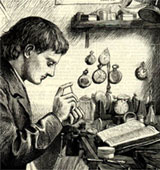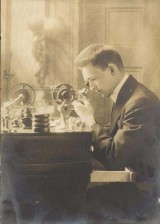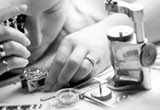EducationPressemitteilungen/Werbung
Job description watchmaker and watchmaker master
The training as watchmaker is the starting point for flexible professional orientation in the different areas of watch and jewellery making and device production. It is future-oriented and due to the broad range can be the basis for professional advanced education in many occupations that require craftsmanship and technical skills and creativity. Watchmakers have been high in demand these last decades especially due to the massive demand for mechanical watches and have the best career chances!
 |
| Ill.: Watchmaker at work |
General work characteristics
The work area of watchmakers today is determined on the one hand from the technical versatility of watches and the materials used in watch production, and on the other hand from the additional tasks that arise from the regulation about the new job description for the watchmakers craft. The necessary, continuous adaptation of knowledge and skills to the technological development as well as the added tasks like restoring historical watches and service work in the jewellery range require a high level of technical understanding and a special adapting ability to the consistent change of tasks.
The watchmaker performs his work mostly in a seated position at a worktable constructed for precision work. The actual work surface of the table has two supports for the lower arms at the front. The achieved relief of the hands guarantees safe handling of the small tools and exact performance of the work. The constantly needed tools like magnifying glass, pinchers, oil device, dust blower, tool holder and a set of small screwdrivers are ready for use on the work table. The tools not needed as frequently are well reachable and organized in two drawer rows right and left of the worktable. Every well-equipped workshop has a lathe, a cleaning machine for smaller clockworks, an ultrasound unit for cleaning large and small watches, watch cases and jewellery, an electronic time scales (regulating and testing device), a quartz timer for testing and setting quartz controlled watches, a tester for water tightness control and other testing and measuring devices for the determination of electronic values.
 |
| Ill.: The training as watchmaker |
Only in rare cases the watchmaker has construction plans, drawings or other documents available for the work in the area of disassembly, assembly and repair of clockworks and accessories. His experience and trained mind alone help him to perceive constructive connections and the logic of mechanical and electronically installations quickly. These skills are a necessary requirement for finding errors in clockworks and electronic components. The success of is work is therefore largely dependant as to how far he is able to break down mechanical or electrical interferences to cause and effect. The level of difficulty of troubleshooting and the performance of the different work procedures is directly associated with the size of the object to be worked on. Watches whose smallest parts can no longer be inspected with pure eyesight are examined with the magnifying glass. The watchmaker uses a forceps to grasp the small parts. A direct workbench lamp must provide bright light for the dust free working area.
Contrary to the servicing work, the watchmaker needs corresponding drawings or sketches to produce shafts, wheels, levers and other parts. As they are not given or procurable in the workshop, these work documents must be created by the watchmaker. He either uses the part that forms a functional unit with the part to be replaced for shapes and dimensions, or calculates them from the given measurement of the clockwork.
Due to the difference of repair and manufacturing work, teamwork in the watchmaker’s workshop only makes sense and is only possible in the case of larger and equal order units. As this is rarely the case, the work as a watchmaker is usually a typical single-man’s work.
A main focus of the work of a watchmaker is still the servicing and repair of large and small clockworks and their additional installation and accessories. Before a clockwork is dissembled it must be inspected for possible errors and functional defects, so that their elimination can be performed in a beneficial sequence with the further work. After troubleshooting in the clockwork the casing and other parts of the watch are examined for their condition and damages. Sometimes this already results in indications of defects of the clockwork functions that were not discovered before. After these inspections are finished, the clockwork is removed from the casing. The single components of the clockwork are now inspected for possible defects according to a certain system. Apart from few exceptions, the mechanical small clockwork consists of six of such components: drive, running gear, suspension, swinging system, lift and movement. The visual inspection is followed by the disassembly of the entire work, during which defective parts are replaced. If the object of repair is an older watch, the corresponding spare parts must be manufactured by hand. After all found errors were eliminated and the defective parts of the watch were replaced the work and the watch are cleaned. In the framework of the following assembly work the bearings and places of friction are lubricated depending on strain and condition of the material. Subsequently the clockwork is adjusted, subjected to a last function control and regulated. The watchmaker has an electronic testing device available for the final inspection of a mechanical small clockwork, which gives him exact information about the regulating behaviour of the watch in different situations. The final inspection of a quartz-controlled watch is similar, only that it is not called regulating but balancing, and that this final inspection is done with the help of a quartz timer.
Besondere Aufmerksamkeit ist schließlich dem Uhrgehäuse zu widmen. Häufig handelt es sich um wertvolle Schmuckobjekte aus Edelmetall mit integrierten oder angesetzten Goldbändern. Besondere Sorgfalt ist hier geboten, weil schadhafte Bandverschlüsse, abgenutzte Bandstege oder Bruchstellen im Gliederverbund des Bandes zum Verlust der gesamten Uhr führen können. Gleichzeitig müssen gefasste Diamanten, Perlen oder andere Zier- und Schmuckelemente des Uhrgehäuses auf Sitzfestigkeit und Abnutzung überprüft werden. Die Beseitigung eventueller Schäden oder die Erneuerung einzelner Band und Gehäuseteile, Steinfassungen usw. erfolgt nach den Regeln des Hartlötens und der entsprechenden galvanischen und mechanischen Oberflächenbehandlung. Hierfür stehen in der Werkstatt die erforderlichen Einrichtungen zur Verfügung.
 |
| Ill.: Watchmaker at work |
Ultimately, the watch casing deserves special attention. Quite frequently they are valuable jewellery objects made of precious metal with integrated or put on gold bands. This requires special care, because damaged band clasps, worn bridges or tears in the chains of the band may lead to a loss of the entire watch. At the same time set diamonds, pearls or other decorating or jewellery elements of the watch casing are tested for firm seating and wear. The elimination of possible damages or the renewal of single band and casing parts, stone settings etc. is done by the rules of hard soldering and the corresponding galvanic and mechanical surface treatment. The necessary installations are available in the workshop.
The watchmaker must increasingly adapt to new technologies in his workshop work, where new work procedures are applied just as well. Service work in a conventional sense is no longer possible with partially or fully electronic watches. Thus, the service work of the watchmaker on these types of watches is first limited to the determination of all causes of defect. Electronic control and measurement devices help him to inspect the complicated switch and control processes in the electronic watches and to find defects. If a component is no longer functional, it is usually replaced. Soldered elements are removed with the help of the soldering iron and replaced.
Next to his watch-specific skills and knowledge the watchmaker has solid training in material processing. It includes nearly all methods of steel and metal processing. He is able to work with a file and can produce smallest shafts and cones with the lathe, which are sometimes not thicker than a human hair. He works on steel, any type of soft metal, plastics and other materials in the framework of the spare part production. Metallic connections are created by screwing, pinning, riveting, gluing, soft and hard soldering. The watchmaker needs small and polishing files, many types of tensioning and grinding tools, drills, a lathe tool, a countersink, and a drilling and lathe machine for this work and all other methods of chipless and cutting processing of the materials. This is supplemented by measurement and testing tools as they are used also in other professions in fine precision technology.
Forms of work and promotion, technical special activities
As a micro-mechanic the watchmaker is in demand in nearly all fine precision technology jobs. His skills and knowledge in the areas of fine mechanics, electro technology and electronic enable him to work where mechanical, electrical or electronic counting or register devices are produced, serviced or repaired. Among others, this includes measurement, regulating and counting devices as they are mainly found in gas, electricity and water management.
Watchmakers in the industry
Due to the far-reaching automation in the watch industry, the watchmaker was promoted to specialist. Main points of his work are the entry inspection of watch parts to be processed, the final inspection of finished watches, the repair of damaged time measuring instruments, the work organisation for his trained co-workers and the training of aids. According to his preference he usually specialises on the production areas of small or large watchmakers. But also producers of works, faces and casings require watchmakers for construction works and quality inspections.
Watchmaker in spare parts
Watchmakers trained in spare parts are put in a managing position. From their training they possess the necessary knowledge to be able to determine the traded spare parts according to function and brand association. The companies of spare parts trade are usually wholesale companies of the watch and jewellery branch that have a department for machines, tools, watches and jewellery next to a spare part department. The watchmaker in spare parts thus has many options to take over special tasks beyond his actual range of work. One especially interesting area is the work in the tool and machine department.
Special tasks due to business
Watchmaker workshops as pure crafts shops are very rare. Usually they are an integrated part of the specialist stores for watches, jewellery and time measuring technology. About 80 % of all non-self-employed watchmakers find a job here. The profession-specific task areas in trade, craftsmanship and industry guarantee the ambitious watchmaker high professional mobility and regional independence. His chances in companies in micro-mechanics are just as excellent as in businesses of low current and entertainment technology.
Watch specialist
In medium and larger specialist shops the required work process of repairs in the workshop is often disturbed by the fact that next to the pure repair work, the creation of cost estimates, prices calculation and the associated customer consulting needs to be done. Businesses with high repair occurrences avoid this by employing flexible and sociable watchmakers as watch specialists in customer care. They take over all preoperational work associated with every order, similar to the work in vehicle repair.
Specialisation forms by learning special skills and knowledge in additional training
Specialist dealer in watch and jewellery retail
In many specialist stores the watchmaker is offered the opportunity to gather experience in the sales of watches and jewellery next to the performance of his craft. This opportunity should be used especially if the person has the intention of later managing a retail store in the watch or jewellery branch or to found an own company. Practical sales experience as well as a good knowledge of the products is necessary for successful management.
The change from workshop watchmaker to specialist dealer can usually be done step by step. Depending on the interests and professional work the watchmaker will decide himself whether he wants to work in sales in whole or in part later on. The basic knowledge gained within the company for the specialist dealer can be supplemented by visiting the branch school in Königstein/Ts.
Combination of two professional educations
Due to economic reasons and the related fine precision engineering watchmaking and optician craftsmanship are often performed in a combined form in smaller villages. The corresponding training certificates must be done in both professions before the combination profession may be performed in one business.
Types of promotion
The promotion within the profession is regulated up to reaching the master title. After an education with final exams the watchmaker is able to work as a journeyman/skilled worker in a non self-employed position. During this time he has the opportunity to expand his knowledge and skills. Preparation seminars at the watchmakers schools or training centres serve the preparation for the master exam. Technicians of the special field fine precision technology are preferred for the technical means management in the industry if they learned to be watchmakers before.
Workshop manager
Larger workshops in craftsmanship and the industry are usually managed by a workshop manager. Among other things, he is responsible for the proper processing of all incoming orders up to the calculation of the sales price. He is responsible for the work organisation, creates cost estimates and works as a connecting link between the workshop and sales. He supervises and supplements the spare parts warehouse and is also responsible for the technical instruction of the trainees. This requires a master’s title.
Manager
Larger businesses and branch offices of the watch and jewellery retail employ watchmaker masters with corresponding commercial experience as managers. A manager must be able to manage a retail business with associated workshop independently. Among other things this includes sufficient goods knowledge for purchase and sales and specialist knowledge in the areas of advertisement, store window design.
More Information: Der Uhrmachermeister

